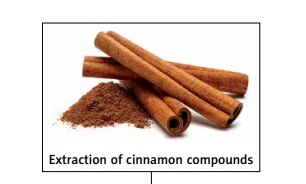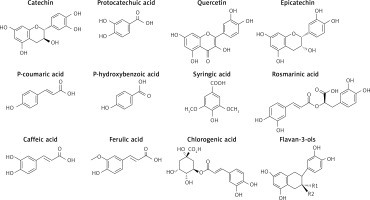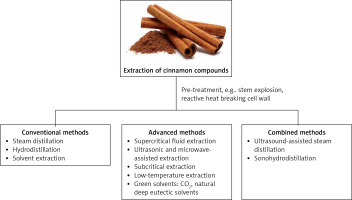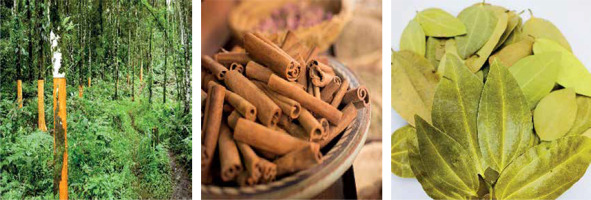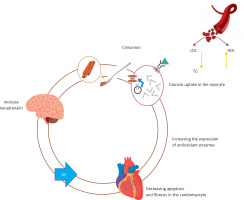Introduction
About 1/3 to 1/5 of cardiovascular disease (CVD) cases are associated with myocardial infarction and heart failure [1]. Some risk factors for CVDs are smoking, stress, and diseases such as diabetes, atherosclerosis, and hypertension [2]. The application of common therapies for CVDs is associated with side effects, that is why the use of herbal medicines is considered due to less side effects, and being cheap [3]. Herbal medicines have antioxidant, immune regulatory, and anti-inflammatory properties against CVDs [4, 5].
The main commercial species of cinnamon are Cinnamomum verum, Cinnamomum burmannii, Cinnamomum cassia, and Cinnamomum loureiroi [6, 7], and the most common species are Cinnamomum cassia (Saigon Cinnamon) and Cinnamomum verum (Ceylon Cinnamon) [8]. Saigon Cinnamon is the most well-known and is found in Vietnam, China, and Sunda Islands. Ceylon Cinnamon as one of the best types of cinnamon is an evergreen tree with 5–7 m and is native to India, Bangladesh, and Myanmar [8]. Leaves and bark of cinnamon trees have been used as herbal medicine, flavoring, or spice and the most consumed part of the plant is the bark [7]. Bioactive compounds of cinnamon are against inflammation, oxidative stress, diabetes, obesity, hypertension, and high blood lipid levels [9, 10]. In traditional medicine, cinnamon has been used for arthritis, infections, as an analgesic agent, and for wound healing [9]. It’s reported that it may impact the risk of cardiovascular diseases, diabetes, and cancer. The effect of cinnamon on lipid levels or plasma glucose indicated promising results [11].
This review is to highlight the scientific studies revealing the cardiovascular beneficial effects of cinnamon on CVDs.
The bioactive compounds
The main components of cinnamon are cinnamaldehyde and trans-cinnamaldehyde which are linked to fragrance and its biological properties [7] Catechins and procyanidins; proanthocyanidins or condensed tannins are found in the cinnamon bark which belongs to the flavan-3-ols as important flavonoids [12]. As stated by Vallverdu-Queralt et al., the most abundant bioactive compounds found in cinnamon are catechin, protocatechuic acid, quercetin, epicatechin, p-coumaric acid, p-hydroxybenzoic acid, syringic acid, rosmarinic acid, caffeic acid, ferulic acid, and chlorogenic acid [13] (Figure 1).
It is reported that cinnamon is rich in cinnamaldehyde, cinnamic acid, cinnamate, and eugenol as the main components [9, 14]. It is reported that amidone, mucilage, tannin, calcium oxalate, sugar, essential oil, and resin also were found in cinnamon [15].
Cinnamic, cinnamyl acetate, cinnamaldehyde, procyanidins, polysaccharide, and catechins are major components in the cinnamon bark. A higher concentration of cinnamaldehyde has shown cardiovascular protective properties while cinnamic acid, coumarin, cinnamyl alcohol, and eugenol are used for flavoring and perfumes [16]. The common extraction methods for cinnamaldehyde, cinnamic acid, cinnamate, and eugenol as the main components of cinnamon are steam distillation, hydro-distillation, and Soxhlet extraction [17, 18]. Hydro-distillation is more used because of its low cost, easiness, and lack of solvent residue. But generally, its yields are low (1–2%) [19], thus other extraction methods such as supercritical CO2 extraction, ultrasonic, microwave-assisted extraction, and low-temperature extraction have been performed to increase extraction yields [20, 21] (Figure 2).
Health benefits of cinnamon
According to traditional medicine in Iran and India, the temperament of Ceylon and Saigon cinnamons is warm and dry [22]. Cinnamon has been used to cleanse the breast, treat coughing and shortness of breath, and thick phlegm, and is used for obsessive-compulsive disorder, panic, insanity, stomach ache, relieving fever, and reduction of joint and back pain. In India and China, it is proven that Ceylon cinnamon’s bark is a stimulant for the digestive, respiratory, and kidney diseases and accelerates blood flow. In contrast, Saigon cinnamon is used as a spice due to its flavor. In traditional Far-Eastern medicine, cinnamon has been advised as a stomach booster and sedative, applied for postpartum pain, and increases the body’s secretions [22] (Figure 3).
Cinnamon is an anti-clotting agent and prevents atherosclerosis. In addition, it decreases blood cholesterol and insulin resistance, stabilizes blood sugar, and maintains LDL. Cinnamaldehyde dilates blood vessels and helps relieve the tension due to blood pressure. Ingesting 6 g of cinnamon daily lowers triglyceride and total cholesterol in type 2 diabetes. Cinnamon can reduce inflammation that is triggered by obesity [22].
Cinnamomum zeylanicum has a blood pressure lowering effect in rat models [23] as well as suggesting in type 2 diabetic and pre-diabetic humans a NO-dependent mechanism for the antihypertensive effects of C. zeylanicum [24]. Nonetheless, outcomes of a placebo-controlled clinical trial showed that cinnamon does not affect BP in type 2 diabetic cases [14]. Cinnamon affects regulations and mimics, which may have a moderate effect on lowering fasting blood sugar in diabetes. Cinnamon can also keep blood sugar steady throughout the day [25]. Cinnamon reduces the production of the inflammatory molecule of thromboxane A2 in patients suffering from heart diseases. Also, cinnamon’s anti-inflammatory properties prevent the release of arachidonic acid (inflammatory fatty acid) that promotes plaque formation in the arteries. Cinnamon is a rich source of flavonoids and antioxidants which are anti-inflammatory and decrease heart diseases [22]. Cinnamon and cinnamaldehyde have prebiotic effects as well that may restore the balance of gut bacteria and improve digestive functions [22].
Beside many other factors, subspecies, extraction mode and galenic properties influence the required doses [26]. Cinnamon is generally safe when used in small amounts. Usually, it is used about 1–6 g depending on the weight. Since Saigon cinnamon contains higher coumarin (5.8 to 12.1 mg) than Ceylon cinnamon, so one should reduce its intake [26].
The effect of cinnamon on the cardiovascular system
As explained in the previous parts of the current review, the most important compounds of cinnamon are cinnamaldehyde, cinnamic acid, eugenol, and coumarin [27], out of which cinnamaldehyde is the main bioactive compound (60–75%) [28]. This compound has protective effects on cardiovascular conditions like cardiac ischemia and hypertrophy, and myocardial infarction [29, 30]. Using 100 mg cinnamon/kg body weight for 2 weeks had significant antioxidant ability in reducing the complications related to oxidative stress and increased total antioxidant power by reducing lipid peroxidation. Cinnamon supplementation improves the performance of the heart and increases coronary flow by enhancement of cardiac performance [31].
The consumption of 500 mg cinnamon/kg body weight in type 2 diabetic patients for 2 months reduced blood sugar and lipid levels. Using cinnamon along with turmeric, and chili pepper in CVD patients for 11 years showed that cinnamon did not affect blood lipids and CVDs. Daily consumption of 1 g cinnamon powder/kg body weight for 16 months in male diabetic patients reduced diabetes complications [22].
The effect of cinnamon on atherosclerosis
There is an accumulation of cholesterol and inflammatory cells in the artery wall in atherosclerosis [32]. Atherosclerosis causes cardiovascular diseases such as myocardial infarction, stroke, and ischemic heart failure [33]. Inflammation and oxidative stress play a key role in cardiovascular diseases. It is confirmed that the therapeutic properties of cinnamaldehyde improve oxidative stress-mediated cardiovascular diseases, in atherosclerosis patients [34]. It is declared that cinnamaldehyde protects smooth muscle cells against LDL oxidation-induced proliferation [34]. The protective and anti-inflammatory effects of cinnamaldehyde on the oxidative stress induced by H2O2 in the endothelial cells of the human umbilical vein in Sprague-Dawley rats in vivo were proved [35]. It’s concluded that cinnamaldehyde could inhibit atherosclerotic damage in the aortas due to antioxidant effects in ovariectomized female mice [30]. The effects of cinnamaldehyde on the vascular damage induced by a high-cholesterol diet in rabbits were reported [36]. Also, cinnamaldehyde improved atherosclerosis in hypercholesterolemic rabbits by decreasing cholesterol and antioxidant and anti-inflammatory properties. The researchers declared that cinnamon showed preventive effects on the formation of atherosclerotic plaques, which inhibits the increase of fibrosis, neutrophils, and hypertrophy and reduce NO concentration [23, 37]. Cinnamon leads to the reduction of negative inotropic and chronotropic effects in the heart, the relaxation of the VSM wall, and the improvement of systolic and diastolic failures by reducing the calcium channel activity [38].
The effect of cinnamon on anti-platelet aggregations
Prolonged use of anti-platelet aggregation drugs has various side effects, therefore natural sources have been considered. Some compounds of cinnamon C. cassia such as eugenol, amygdala, cinnamic alcohol, 2-hydroxy cinnamaldehyde, 2-methoxycinnamaldehyde, and conifer aldehyde displayed antiaggregatory activity [25]. Cinnamaldehyde inhibited platelet aggregation induced by collagen and thrombin in vitro and platelet aggregation in vivo [39]. The administration of cinnamaldehyde to mice inhibited platelet-related thrombosis. Eugenol in cinnamon reduced platelet aggregation by inhibiting thromboxane A2. The administration of cinnamaldehyde to aortic banding mice mitigated the development of pathological cardiac hypertrophy and heart failure [40]. Cinnamon extract had anticoagulant and anti-aggregation properties for the platelets [8]. Administration of cinnamon to hypercholesterolemic rats increased HDL and decreased triglyceride and LDL cholesterol levels [8]. The cinnamon may prevent the release of arachidonic acid from phospholipids of platelet membrane and reduces the production of thromboxane A2. Also, it decreases triglyceride, LDL, and total cholesterol and increases HDL. Because LDL and Ox-LDL have a high affinity for CD36 that cause platelet activation, thus a reduction in LDL decreases platelet activation [8] (Figure 4).
The effect of cinnamon on blood lipids
Using one cinnamon extract capsule (250 mg/kg body weight) in type 2 diabetes patients for 2 months reduced total cholesterol (TC), HDL, and LDL [41]. Also, in type 2 diabetes patients, using cinnamon (3 g) reduced HDL and LDL [14]. The practice of 500 mg cinnamon extract/kg body weight for 1 year had no advantageous effect on electrocardiogram (ECG) indicators in at-risk diabetic persons [42]. Hyperlipidemia is linked with a high incidence of myocardial infarctions and cardiovascular diseases. The cinnamaldehyde and polyphenols present in cinnamon have antihyperlipidemic effects [34]. A study on the blood lipids of patients with CVDs and cancer during 11 years proved that cinnamon did not affect CVDs [43]. The use of 300 and 600 mg cinnamon extract/kg body weight alone and with metformin (250 mg/kg body weight) for 30 days in type 2 diabetes rats increased HDL but reduced TC and LDL levels [44]. An alternative study exhibited that 300 mg cinnamon extract/kg body weight for 18 days enhanced HDL and LDL in type 2 diabetes antenatal rats [45]. Daily use of 300 mg cinnamon alcoholic extract/kg along with 20 mg captopril/kg for 4 weeks reduced TC and LDL, increased HDL, and improved atherogenic index in acute hypertension rats [23]. Supplementation of 100 mg cinnamon extract/kg body weight in metabolic syndrome rats for 12 weeks reduced TC and LDL levels and increased HDL [46]. The use of 200 mg cinnamon alcoholic extract/kg/day for 8 weeks in rats improved cardiac hemodynamics, decreased serum malondialdehyde, improved hyperlipidemia, and decreased TC, LDL, HDL, and LDL/HDL ratio [31]. Consumption of 500 and 300 mg cinnamon alcoholic extract/kg body weight improved HDL and reduced TC and LDL levels in type 2 diabetes and hyperlipidemia rats [47, 48]. It is proved that the cinnamon extract in different doses in type 2 diabetes rats reduced alanine aminotransferase, aspartate aminotransferase, and LDH levels [44]. The different impacts of the cinnamon extract on serum parameters are due to differences in the extraction method, the type of solvent, or the dose of cinnamon [49].
According to many studies, cinnamon regulates blood lipids, reduces LDL and TC levels, and improves blood lipids in obese diabetes cases fed with high-fat diets [50]. Although, some studies have declared the protective effects of cinnamon on the heart; however, in some other studies, cinnamon had no beneficial effect on the blood lipid [42]. In many studies, cinnamon reduced HDL levels [41], but further studies need to prove the effect of cinnamon on HDL [45, 51]. Figure 5 shows the effect of cinnamon on serum levels of sugar, lipids, blood pressure, and cardiovascular tissue changes such as apoptosis, inflammation, and fibrosis.
Using a 100 mg cinnamon capsule significantly decreased blood TG and total cholesterol but did not change LDL-c and HDL-c and had a small effect on impaired glucose tolerance in diabetic patients [52]. Supplementation of 1.5 g cinnamon/day for 60 days in type 2 diabetes patients increased HDL and reduced triglyceride and cholesterol levels [53, 54] (Figure 6).
Figure 6
The effect of the cinnamon extract on blood lipids and the cardiovascular system (adapted from [22])

The utmost substantial risk indicators for cardiovascular changes are the amplified serum cholesterol, TG, LDL, and reduced HDL all of which are linked to oxidative stress. Cinnamon may increase the efficacy of HDL-mediated reverse cholesterol transport, consequently decreasing the cardiovascular disease risk [31].
The effect of cinnamon on blood pressure
Administration of 1–10 mg cinnamaldehyde/kg decreased blood pressure in anesthetized dogs and guinea pigs, due to peripheral vasodilating effects. The hypotensive effects were proved by vasorelaxant action and negative inotropic and chronotropic properties on the heart in anesthetized rats [25]. The vasodilatory action of cinnamaldehyde relaxed the rat aortic rings precontracted with phenylephrine. It’s showed that cinnamaldehyde elevates methylglyoxal-induced vascular damage in the rat thoracic aorta [55]. The aromatic carboxylic acid and cinnamic acid of cinnamon also exhibit vasorelaxant effects in rat thoracic aortas [56] which prove protective effects against myocardial ischemia in Sprague-Dawley rats treated with isoproterenol [57]. According to meta-analyses, the effectiveness of 2 g cinnamon extracts on SBP and DBP for more than 8 weeks was reported [58]. The same effect has been concluded in DM2 patients [59]. The effects on SBP and DBP in patients not older than 50 years are displayed clearly in low doses and longer periods (> 12 weeks) [26]. Another study declared that 1 g of cinnamon per day for 3 months lowered blood pressure in diabetic patients. High blood pressure causes 2/3 of strokes, and 50% of coronary heart disease cases, and is linked to premature coronary artery disease. Using 1500 mg cinnamon capsules for 90 days significantly decreased mean ambulatory SBP and LDL-c, did not change FBS, and increased HDL-c [60]. Cinnamon powder reduced systolic and diastolic blood pressure [61]. In a study on 59 type 2 diabetes patients, a daily intake of 1200 mg cinnamon for 12 weeks reduced systolic blood pressure by an average of 3.4 mm Hg [24].
Cinnamon and diabetes
Currently, diabetes is regarded as the most common metabolic disorder in society, and the prevention of cardiovascular issues in diabetic patients is important. The protective effects of cinnamaldehyde against hypertension in streptozotocin-diabetic and fructose-fed insulin-resistant rats were reported. Furthermore, cinnamaldehyde reduced fibrosis and cardiac inflammation in fructose-fed rats which displayed metabolic syndrome [57]. The antihyperglycemic and antihyperlipidemic function of cinnamaldehyde in insulin-resistant mice was reported after oral administration of cinnamaldehyde. The polyphenols of cinnamon improved regulating blood glucose in humans [62]. The phenolic compounds, catechin, epicatechin, and procyanidin B2 as flavonoids in cinnamon can reduce blood sugar by reducing glycogen synthesis, glycogenolysis, and glucose absorption in the intestine [25]. Furthermore, polyphenols such as rutin, catechin, quercetin, kaempferol, and isorhamnetin in cinnamon can diminish insulin activity and improve glycemic control [7]. The consumption of 500 mg cinnamon/kg body weight in type 2 diabetes patients for 2 months reduced blood sugar and lipid levels [63]. Also, using cinnamon extract capsules (250 mg/kg body weight) in type 2 diabetes patients for 2 months reduced total cholesterol, HDL, and LDL. The consumption of cardamom (3 g), cinnamon (3 g), ginger (3 g), and saffron (1 g) for 8 weeks reduced HDL and LDL in type 2 diabetic patients. Regarding the research, using 500 mg cinnamon extract/kg body weight for 1 year in pre-diabetic patients had no beneficial effect in improving electrocardiogram indicators [23]. It is proved that cinnamon significantly reduced FBG and HOMA-IR, in T2DM and pre-diabetes patients compared to placebo [64].
Cinnamon and obesity
Obesity is strongly linked with cardiovascular diseases. The phytochemicals may be good candidates for anti-obesity drugs due to fewer side effects [25]. The anti-obesity effects of cinnamaldehyde were studied for 8 weeks on mice fed a high-fat diet [28]. Cinnamaldehyde and cinnamic acid have anti-obesity and cardioprotective properties. Also, cinnamaldehyde decreased body weight, fat mass, serum lipid, free fatty acid, and leptin, improved insulin sensitivity, prevented adipose tissue hypertrophy, and induced browning of white adipose tissue in comparison with the controls [65]. It decreased hyperlipidemia and body weight of obese rats on the high-fat diet and protected animals against hypertension and vasoconstriction problems. Supplementations with 2 to 3 g of cinnamon per day significantly impacted the bodyweight, obesity which is linked with cardiovascular disorders. It delayed gastric emptying, gastrointestinal motility, and release of serotonin from enterochromaffin cells. That way it reduces visceral fat deposits as it boosts interscapular brown adipose tissue and thermogenic protein. It also increases glucose transport, insulin β receptors, and zinc finger protein 36 in the adipocytes, and decreases leptin amount [66]. Daily use of 3 g of cinnamon for 8 weeks significantly reduced body fat mass in type 2 diabetes patients [67].
Conclusions
Cinnamaldehyde and cinnamic acid are the main compounds of the cinnamon with protective effects on cardiovascular diseases. Previous studies have reported the beneficial effects of cinnamon on lipid profiles, fasting glucose, blood pressure, cardiovascular disease, diabetes, and consequently mortality. Cinnamon is effective in preventing and treating CVDs by lowering blood lipids and blood pressure and improving the oxidants: antioxidants balance. Therefore, cinnamon has protective effects on the cardiovascular system by reducing oxidative stress and increasing HDL, reducing ischemic damage such as apoptosis in the heart tissue, reducing blood pressure, and having anti-arrhythmic effects (Table I).
Table I
Overview on the cardiovascular protective properties of cinnamon
| Cinnamon | Dose used | Case | Results | Reference |
|---|---|---|---|---|
| Cinnamomum burmannii 60 g/1 l water, heated at 100°C for 30 min | 100 ml/day, oral single dose | 30 non-diabetic cases (20–53 years) | Slightly decreased postprandial blood glucose after 2 h | Bernardo et al., 2015 [68] |
| Cinnamomum burmannii Extract Herbilogy® | 2, 4, and 8 mg/kg B.W, orally for 28 days | 30 male, Swiss Webster mice on a high-fat diet | Decreased total cholesterol | Pulungan and Pane, 2020 [69] |
| Cinnamomum burmannii Fine powder | 2 g per day, 8 weeks | 36 women aged more than 18 years, rheumatoid arthritis pre- and postmenopausal | Significant decrease in serum TNF-α, CRP, diastolic blood pressure and swollen joint count, and blood pressure | Shishehbor et al., 2018 [70] |
| Cinnamomum cassia Bark | 1.5 g for 60 days | 99 type 2 diabetic patients | Reduced HbA1c, glucose, triglyceride, TG/HDL-C ratio, BP, and increased HDL and eGFR | Sengsuk et al., 2016 [53] |
| Cinnamomum cassia Spray-dried aqueous extract | 250 mg twice a day, 2 months | 137 Chinese, mean age 61 years, fasting serum glucose: > 6.1 mmol/l | Reduced fasting insulin, glucose, total cholesterol, and LDL, improved insulin sensitivity | Anderson et al., 2016 [41] |
| Cinnamomum verum Bark powder | 3 g/day, 8 weeks | 99 women with dyslipidemia | Reduced total cholesterol, triglyceride, and HDL, BW, BMI | Pishdad et al., 2018 [71] |
| Cinnamomum zeylanicum | 85, 250, and 500 mg aqueous for 3 months | 28 healthy subjects | Reduced systolic and diastolic blood pressure and cholesterol. Renal and liver function, fasting blood glucose, HDL-c, VDL-d, and triglycerides were in the normal range, no changes in the anthropometric parameters | Ranasinghe et al., 2017 [72] |
| Cinnamomum zeylanicum Bark powder | Three capsules of 500 mg/daily for 8 weeks | 84 polycystic ovary syndrome women | Increased total antioxidant capacity and Malondialdehyde decreased. Improved total cholesterol, HDL, and LDL | Borzoei et al., 2018 [73] |
| Iranian cinnamon powder | 3 g/day8 weeks | 39 type 2 diabetes patients, body mass index 27.7 | No significant effect in reduction of NF-κB, SIRT1, hs-CRP, IL-6, and TNF-α | Davari et al., 2020 [74] |
| Cinnamic acid | 30 mg/kg/day for 7 weeks | Rats fed high-fat diet | Anti-obesity and cardioprotective | Mnafgui et al. (2015) [65] |
| Cinnamaldehyde | 50 mg/kg for 7 weeks | Cardiac hypertrophy-induced mice by aortic banding | Improve cardiac hypertrophy and fibrosis | Yang et al. (2015) [40] |
| Cinnamaldehyde | 10–100 µM | Isolated rat aortae subjected to vascular damage by methylglyoxal | Vasculoprotective effects | Tarkhan et al. (2018) [55] |
| Cinnamon powder | 1000 mg/kg, 16 months | Type 2 diabetes cases | Preventing cardiac ischemia | Crawford et al. (2018) [70] |
| Cinnamon extract | 500 mg/kg, 2 months | Type 2 diabetes cases | Decreased TC, HDL, LDL | Anderson et al. (2016) [41] |


